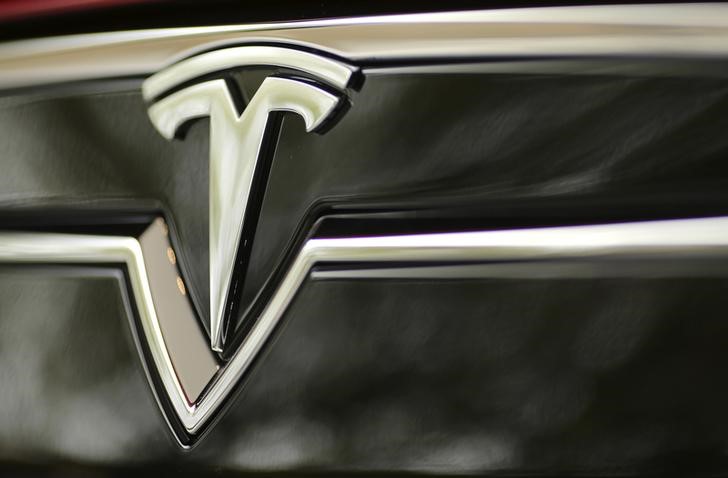By Hyunjoo Jin, Akash Sriram and Joseph White
(Reuters) – Tesla (NASDAQ:) CEO Elon Musk said on Wednesday that he was concerned about the impact of high interest rates on car buyers, adding the electric vehicle maker was hesitating on its plans for a factory in Mexico as it gauges the economic outlook.
After the company missed Wall Street expectations on third-quarter gross margin, profit and revenue, Musk said he wanted to get a better sense of where the economy was headed before going “full tilt” on the Mexico factory.
“If interest rates remain high … it’s that much harder for people to buy the car. They simply can’t afford it,” he said on a conference call with analysts.
Tesla has managed to maintain demand with a series of price cuts, but Musk spent much of the call voicing concerns about further expansion, saying that he was afraid rising interest rates would make cars unaffordable.
The price of the popular Model Y SUV was “almost unchanged” for consumers even after Tesla’s price cuts, Musk said, accounting for higher financing costs.
The automaker in March announced plans for a new factory in Mexico’s northern state of Nuevo Leon that the state government estimated would cost more than $5 billion, though Tesla has yet to share a capital cost forecast.
Pressed for details on the factory, Musk said: “I am scarred by 2009 when General Motors (NYSE:) and Chrysler went bankrupt. I don’t want to be going at top speed into uncertainty.”
He also said there would be “enormous challenges” in reaching volume production for Tesla’s long delayed Cybertruck pickup and making it cash flow positive.
Shares in the company fell 3% in after-hours trading on Wednesday. They had closed down 4.8%.
PRICE CUTS
Tesla’s aggressive price cuts this year have battered its gross margin even as it faces stiff competition in China from local automakers.
The company is trying to survive the price war it started, mopping up any demand for electric cars in the market even as high interest rates and price tags at rivals mute EV sales. Some analysts have said it may need to cut prices further to achieve its annual production target .
In the third quarter ended September, gross margin fell to a more-than four-year low and the company signaled it would keep cutting production costs to boost profits.
Still, it stuck to its annual production target of 1.8 million cars, a sign that the price cuts were buoying demand to an extent.
Its stock has more than doubled this year as investors bet the company will fare better than rivals in an uncertain economy and get a long-term margin boost from its self-driving software, but scrutiny over its position in China, the world’s largest auto market is rising.
“Tesla’s worrying China sales figures indicate demand for its vehicles is slowing more than expected in the face of rising competition from local EV companies, including BYD (SZ:), Nio (NYSE:), and XPeng (NYSE:),” said Jesse Cohen, senior analyst at Investing.com
“The big question is if this is just a blip, or signs of a bigger shift among consumers as rising interest rates and a weaker economic backdrop discourage consumers from making big-ticket purchases.”
MARGIN FALLS
Tesla’s gross margin dropped to 17.9% in the quarter ended September, compared with 25.1% a year earlier, when it had yet to start the price cuts. In the second quarter, Tesla had posted a gross margin of 18.2%.
Wall Street had on average expected Tesla to post a margin of 18.02%, according to 21 analysts polled by Visible Alpha. According to LSEG data, an average of 17 analysts polled expected 18.25%.
Automotive gross margin, excluding regulatory credits – a closely-watched figure – fell to 16.3% in the third quarter from 18.1% in the second quarter.
Margins fell despite a roughly $2,000 per vehicle reduction in raw material costs in the past quarter.
Tesla said its margin had taken a hit from the underutilization of new factories and an increase in operating expenses driven by its upcoming Cybertruck model as well as spending on artificial intelligence and other projects.
Revenue in the third quarter rose 9% to $23.35 billion, compared with analysts’ estimates of $24.1 billion. That marked the slowest pace of growth in more than three years.
Its average revenue per unit declined by nearly 11% from a year earlier.
On an adjusted basis, Tesla earned 66 cents per share. Analysts had expected a profit of 73 cents per share, according to LSEG data. It was not immediately clear if the numbers were comparable.
Tesla said its energy business, which sells solar panels and batteries, as well as its services business, had become a meaningful contributor to profit with more than $500 million in combined gross profit in the quarter. (This story has been refiled to correct a typographical error in paragraph 4)
Read the full article here
